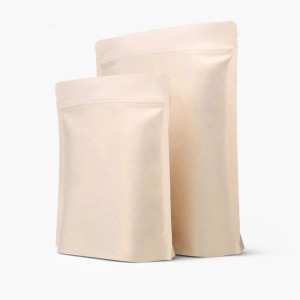
Cotton Paper Biodegradable Bag with zipper and Hang Hole
FEATURES
• Multiple opening options
• Easy open tear nicks, laser cut tear off top and resealable options are available without compromising product quality.
• 4-side printing
• Utilise the four key printing sides to showcase your brand and educate consumers on your product.
• Reduce food spoilage
• The high barrier option means greater reduction of food waste through increased shelf-life.
• Personalised design options
• Opt for a matt or gloss finish or utilise the 10 colour gravure printing to personalise for your brand.
All About The Paper Bag: Its History, Inventors and Types Today
The big brown paper bag has a long, interesting history.
Brown paper bags have become a fixture in our daily lives: we use them to carry groceries home, tote our department store purchases, and pack our kids’ lunches. Retailers use them as a blank canvas for their branded product packaging. Creative trick-or-treaters even wear them as masks for Halloween. It’s easy to forget that someone, long ago, had to invent them!
The Innovators Who Gave us the Paper Bag
For centuries, sacks made of jute, canvas, and burlap were the primary method of holding and moving goods throughout the British Empire. The main benefit of these materials was their sturdy, durable nature, but their production proved both time-consuming and expensive. Paper, on the other hand, could be produced at a much lower cost, and soon became the preeminent material for portable bags along trade routes.
Since its introduction in the 1800s, the paper bag has undergone numerous upgrades thanks to a few clever innovators. In 1852, Francis Wolle invented the first machine to mass-produce paper bags. While Wolle’s paper bag looked more like a large mailing envelope than the grocery store mainstay we know today (and thus could only be used to tote small objects and documents), his machine was the catalyst for the mainstream use of paper packaging.
The next important step forward in the design of the paper bag came from Margaret Knight, a prolific inventor then working for the Columbia Paper Bag Company. There, she realized that square-bottomed bags, rather than Wolle’s envelope design, would be more practical and efficient to use. She created her paper-bag making machine in an industrial shop, paving the way for the widespread commercial use of paper bags. Her machine proved so profitable that she would go on to found her own company, the Eastern Paper Bag Company. When you bring food home from the supermarket or purchase a new outfit from the department store, you’re enjoying the fruits of Knight’s labor.
These square-bottomed bags were still missing a classic component of the paper bag that we know and love today: pleated sides. We can thank Charles Stillwell for this addition, which made the bags foldable and thus easier to store. A mechanical engineer by trade, Stillwell’s design is commonly known as the S.O.S. bag, or "self-opening sacks."
But wait — there’s more! In 1918, two St. Paul grocers by the names of Lydia and Walter Deubener came up with an idea for yet another improvement to the original design. By punching holes into the sides of paper bags and attaching a string that doubled as a handle and bottom reinforcement, the Deubeners found that customers could carry almost 20 pounds of food in each bag. At a time when cash-and-carry groceries were replacing home delivery, this proved a crucial innovation.
What Paper Bags Are Made Of?
So just what materials is a paper bag actually composed of? The most popular material for paper bags is Kraft paper, which is manufactured from wood chips. Originally conceived by a German chemist by the name of Carl F. Dahl in 1879, the process for manufacturing Kraft paper is as follows: the wood chips are exposed to intense heat, which breaks them down into solid pulp and byproducts. Then the pulp is screened, washed, and bleached, taking its final form as the brown paper we all recognize. This pulping process makes Kraft paper particularly strong (hence its name, which is German for “strength”), and thus ideal for carrying heavy loads.
What Determines How Much A Paper Bag Can Hold?
Of course, there's more to picking the perfect paper bag than just the material. Particularly if you need to carry bulky or heavy items, there are a few other qualities to consider when selecting the product that will best serve your needs:
Paper Basis Weight
Also known as grammage, the paper basis weight is a measure of how dense paper is, in pounds, related to reams of 500. The higher the number, the denser and heavier the paper.















